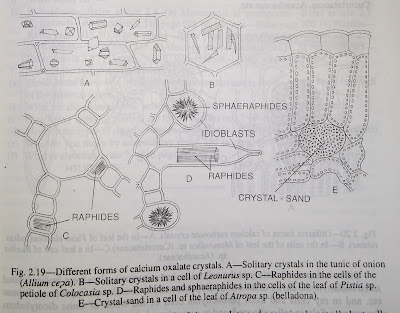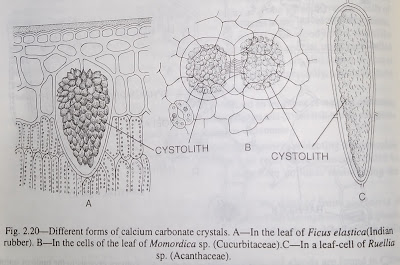Some substances are formed during metabolism which are of no use for the plant body and are termed as
excretory materials. Plants have no excretory system like animals. The waste products are stored in some cells and plants get rid of these waste products in Some peculiar way. Following are the common types of excretory matters noted in plant cells.
(a) Alkaloids-Alkaloids are nitrogenous waste products found in some plants cells. Alkaloids such as morphine, quinine, nicotine, strychnine etc. occur as non-living cells contents in the leaves, roots, bark, seeds etc. of many plants. They are complex compounds containing nitrogen, carbon, hydrogen and oxygen, and occur in dissolved state or as solid Inclusions in the cell sap.
Alkaloids are soluble in alcohol but usually insoluble in water. They are bitter in taste. Some of them are highly poisonous.
Some alkaloids are : quinine present in the cells of the bark of Cinchona sp, morphine present in the cells of the fruit wall of Papaver somniferum, nicotine in the cells of leaves of Ntcotiana tabacum, etc.
(b) Organic acids-Various kinds of acids such as malic (e.g. apple). tartaric (e.g tamarind), citric (e.g. lemon) are found in solution in the cell sap. These acids are soluble in water.
(c) Resins-In composition resin is complex in nature. They occur in some ducts or glands and are non-volatile.
Types of resins-
(i) Hard resins-resins which are soluble in alcohol, solid and brittle e.g., lacquer, shellac etc. Hard resins are used in paint and varnish industry.
(ii) Oleb-resins-resins which are soluble in volatile oils i.e. liquid in nature e.g. canada balsam, terpentines etc., used for the aromatic and sealing purposes.
(iii) Gum-resins are the mixture of gums and resins which are volatile and normally milky in appearance e.g. Asafoetida.
Tests for resins :-(a) Soluble in alcohol and ether. (b) Resin forms a red colour with alkali.
(d) Gums-Cellulose cell wall after decomposition is converted into gums. They are soluble in water. Gums are exuded from.plant cells, e.g. gum arabic (Acacia senegal) of commerce, used as adhesives.
(e) Tannins-Tannins are a heterogeneous group of phenol derivatives, usually related to glucosides. They occur as solution in the cell sap of vacuoles in concentrated state, in parenchymatous cells of pericarp of the fruits or cortex, e.g. the parenchymatous cells of pericarp of the fruit of Carpopogon sp. These are also found in the leaves of many plants, in the xylem and the phloem, in the testa of seeds, in the cell wall, woody parts and in the bark of plants. Tannins may be present in individual cells or in special containers called tannin sacs. They are bitter in taste and act as astringent. Tannins are also found in Acacia catechu, fruits of Tamarindus indica, etc. Tannins are used commercially, Specially in the industry of the tanning of animal skins to obtain leather.
Tests-(1) Dark blue or green colour reaction is obtained on treatment of material containing ‘tannin’ with solution of ferric chloride (FeCl3) or ferrous sulphate and (2) reddish-brown precipitate is formed when treated with aqueous solution of potassium dichromate.
Regarding function, the tannins are interpreted as substances protecting the protoplast against desiccation, decay or injury by animals ; as reserve substances related to carbohydrate metabolism ; as antioxidants ; as protective colloids maintaining the homogeneity of the cytoplasm etc.
(f) Etherial or Essential oils-In glandular cells of the skins of fruits and leaves of
Citrus sp., refractive droplets of etherial oils are found dispersed throughout the cytoplasm. The agreeable sweet scent of flowers is due to the presence of such oil globules in the cells of the petals of flowers e.g. Rosa, Jasminum, etc.
The etherial oils are present in glands or Special cells ; oil glands are found in Citrus sp., Syzygium aromaticum, Eucalyptus globulus, etc.
Tests : (i)Etherial oil is soluble in 90% alcohol ; (ii) with alkali and Sudan III, etherial oils stain red.
(g) Latex-Latex is found in many families of angiosperms and is an emulsion consisting of various substances. The substances are protein, starch grains, sugars, resins, alkaloids, enzymes etc. which are suspended in a watery or milky fluid. It is usually milky in nature. Latex is white, yellow or reddish in colour and is secreted from special type of cells or vessels found in some angiospermic plants. In some CVol (I)-12ases latex contains dumbbell-shaped starch grains.
Latex of the plants Hevea brasiliensis and Ficus elastica is the source of rubber, Latex is also utilised by plants in the healing of wounds. Some plants contain latex which is poisonous. Those poisonous latex protects the plant against the attack of herbivorous animals. The latex of Carica papaya contains papaine, an enzyme utilised in the digestion of the protein food.
(h) Mineral crystals-Many plant cells contain inorganic materials in the form of crystals as by products of metabolic processes. These crystals are of differing chemical composition and are found in many types of cells of the plant. The most common crystals of inorganic compounds are the crystals of calcium salts e.g. calcium oxalate and calcium carbonate. Crystals of other inorganic compounds like gypsum, silica etc. are also found in plant cells but they are less common. The shape of mineral crystals in plants varies very greatly ; they may be prismatic, acicular, pyramidal, rhomboidal, octahedral etc. and are abundant in the cortex, pith and phloem. These crystals lie in the cytoplasm, usually in the vacuoles or in the cavities when the entire protoplast has disappeared as in fibres ; sometimes they remain suspended in the lumen of the cell by projection of the walls. The elongated massive crystals occurring solitarily are called styloids and thin crystals occurrin g in bundles are called raphides.

Raphides --These are crystals of calcium oxalate and occur in almost all plant cells. They are developed in the cytoplasm or within the vacuole and which finally enlarge to fill up the entire cell cavity .The crystals are needle like or prismatic or pyramidal in shape; frequently they are United forming compound structures i.e crystals clusters the druses; Such druses are found in parenchyma cells of the leaves of Amaranthus sp., Daturas stramonium and in the rhizome of Rheum rhaponticum. In aroids e. g species of Colocasia A'locasia and Amorphophallus needle-shaped bundle of crystals of calcium oxalate or acicular raphides with both ends pointed occur in mucilage containing boat-shaped cells called idioblast or any other type of parenchyma cells.
Needle-like or acicular crystals are also common in species of Pistia, Eichhomia, etc. In Pistia, crystals composed of many prisms or pyramids in some cases aggregate together forming a star-like compound structure within the cell ; such form of crystal-clusters i.e druses are called sphae-raphides or sphaerites. In the tunic of Allium cepa rod, cube and prism-Iike crystals of calcium oxalate are also found. Prismatic crystals are also found in the leaves of the species of Citrus, Hyoscyamus, Vicia saliva, etc. Single or twin Prisms either rectangular or pyramidal, may occur.

Cystolith :--In a few plants e.g. Ficus elastica, Ficus benghalensis peculiar cluster of calcium carbonate crystals projects into the protoplast in large specialised cells, particularly of epidermis known as cystolith. So cystolith consists of deposition of CaCO3 around peg. like ingrowths of the cell wall, which appears like a bunch of grapes. Enlarged epidermal cells of the leaf in which cystoliths occur are known as lithocysts. Within the lithocyst, the nucleus remain in a functional condition. Cystoliths are also found in parenchyma and epidermal cells including trichomes or hairs of many plants belonging to families Cucurbitaceae, Acanthaceae etc.
Silica is deposited mainly in the cell walls, but sometimes silica form bodies (called silica bodies) in the cavity of the cell of the plants such as Gramineae, Cyperaceae, Palmae etc. and in ray cells and axial parenchyma cells of the wood of some dicotyledons (Lauraceac). Salts in cell walls are found in some plants belonging to the family Gramineac and in the pteridophytes (Equisetum sp.). The roughness of those plants are due to the presence of such crystals.
Silicon crystals or sandy crystals are very small crystals and often massed together within the cells. The individual Crystals are wedge-shaped or microspheroidal in form. In leaves of Atropa belladonna, in stems of Sambucus nigra, etc. such sandy crystals are observed frequently.
Tests for Cystolith -(i) Calcium carbonate crystals (cystolith) are dissolved in dilute HCl with the evolution of CO2 and (ii) soluble in weak acetic acid.
Tests for Raphide :-(i) Raphides are dissolved in dilute HCl without any evolution of gas. (ii) Raphidcs are insoluble in weak acetic acid .


Thank you very much Samrat,It helps a lot whole studying
ReplyDeleteThanks for reading..if u loved it then share this content to others👍👍
Delete